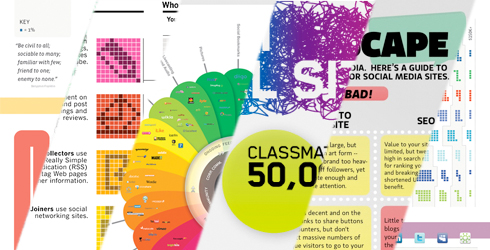

Illustrating an effective use of branded colours and coordinated information, this visual condenses down information which isn’t typically found on a McDonald’s menu.
SOCIAL MEDIA INFOGRAPHIC 2015 MAC
How many of us who have been to McDonalds can say we’ve tried a Big Mac with 8 beef patties? Well according to an infographic by medical, the ‘Monster Mac’ is one of the fast food chains “secret items” that can be purchased upon request. This instructional visual improves comprehension by being archived and immediately accessible to the patient. Visual cues can often make a process seem more informative and, in effect reinforces desired behaviours (Turley & Millman, 2000). The infographic below, provided by Emmi Solutions (2014) provides a visual cue to orchestrate instructions for taking Wardarin: Showcasing a visual dialogue however, can give a patient a complete concept in seconds (Forbes, 2014). According to a report from aafp, (2011), words often fall short of influencing real changes in health.

Infographics have become a staple of healthcare communications. This makes it a massive time saver for users and allows access to the information that matters most. Thereby dulling down on the key financials, even those of a basic political understanding can draw their own judgements into how much the government’s spending without filtering through pages of financial documents. Who really wants to read a large and somewhat confusing list of our governments spending? Too much to digest right? Well thankfully the guys and gals at The Guardian newspaper have designed a breakdown of our countries ingoing’s and outgoings for 2014 with an intriguing visual:įostering a creative use of colour, content and data, The Guardian have embedded a set of important financials with a visual stimulant aimed to abbreviate and magnify the government’s spending. Let’s be honest here, none of us (or very few at least) are going to read over the entire tory manifesto this coming election. “An infographic (short for information graphic) is a type of picture that blends data with design, helping individuals and organisations concisely communicate messages to their audience” (Smicklas, 2012).Įssentially infographics are the crossover point between information and graphic design in order to create a “visual learning experience” The following definition by Mark Smiciklas should give you a more comprehensive idea: It’s usually a collection of data presented in it’s condensed, visual form – you can’t really fail to notice it. The likes are you’ve probably stumbled across one lurking within your Twitter feed on several occasions. Infographics are the cool picture looking artefacts you see hovering around the web. Sounds like a tough obstacle to overcome right? The truth is that something as simple as a picture can outshine words a hundred fold – this is where infographics plays a central role in a brands marketing strategy. What’s more is that rather reading your websites content, they are visualising it to evaluate whether it’s worthy of further engagement. In fact according to data from Tony Haile of Chartbeat (2014), the average user spends fewer than 15 seconds on a webpage. Visual Learning ternet live stats, 2015) the pressure has intensified to polarize ones digital offerings in a fiercely competitive environment. In this post I will be looking at examples of infographics and specifically why they should feature within your marketing strategies for the future. What appears to be a hallmark of the digital medium, was in fact merely popularised by it as visual-centric networks such as Pinterest and Instagram go crazy for these posteresque looking artefacts. Since post noughties emailing phenomena, infographics has lodged its way into the hearts of marketers as a way of communicating tremendous amounts of otherwise boring information.


 0 kommentar(er)
0 kommentar(er)
